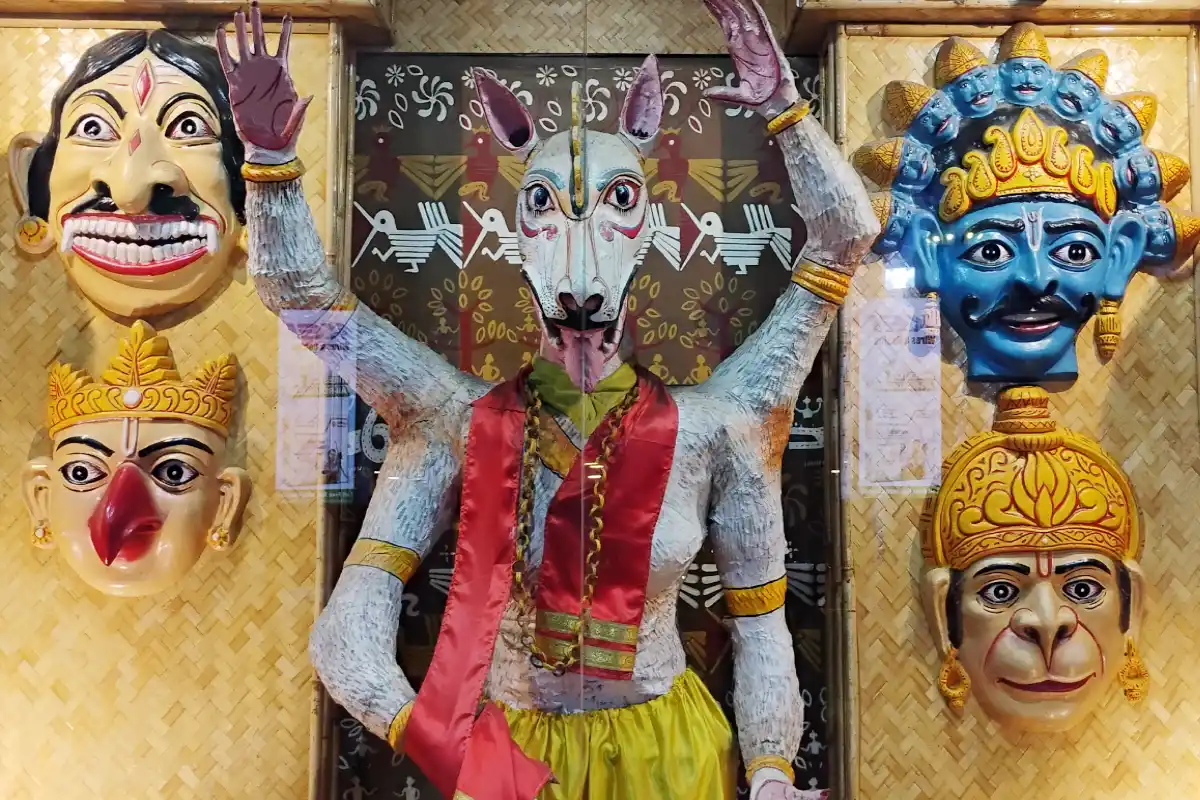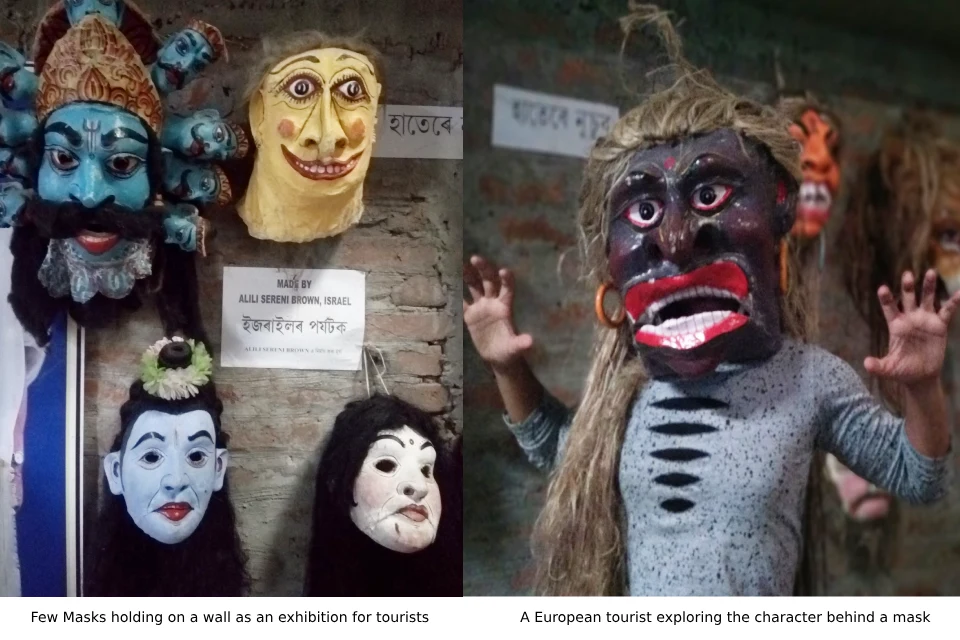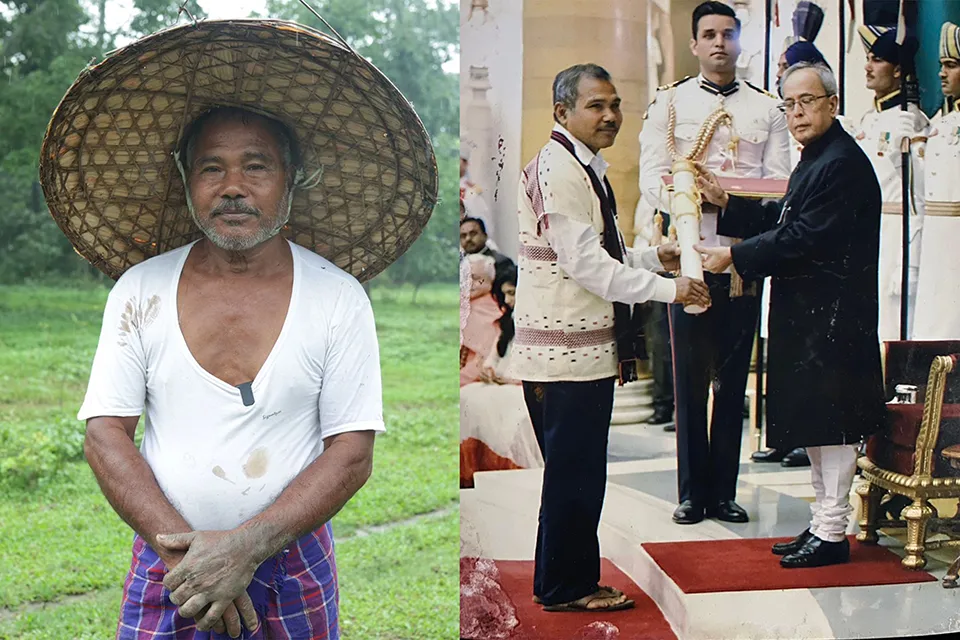Explore the rare artistic treasure of Majuli Masks in Assam and its cultural legacy that attracts tourists from different parts of the world.
Updated on :
Share this post
The art of making Majuli masks has been celebrated for years as a rare and traditional artistic craft. With a cultural legacy of almost 500 years, it has successfully maintained its heritage and attracted a larger population all around the globe.
Assam is a land of artistic treasures carefully preserved for centuries. Every craft has its own cultural significance and ancient history. The successive generations of artisans from Assam have always tried to maintain the legacy of excellent craftsmanship and cultural heritage.
Specific places like Sualkuchi and Majuli are dedicated to preserving traditional art and craft. Be it handloom to jewelry making, architecture to music, Assam holds a rich variety of traditional artworks that have shaped the art and culture of the land.
One such craft is the traditional Majuli masks making art of Assam. It plays an important role in the religious and cultural practices of Assam. The traditional Majuli masks in Assam were given a Geographical Indication (GI) tag on 4th March 2024 by the Geographical Indications Registry of India.

Image: A gallery portraying Majuli masks in Guwahati Railway Station, Assam
Not just for decoration, but these Majuli masks are utilized for religious events and plays. Let’s know in detail where it originated and what’s the current status of this practice.
What is the art of making Majuli masks?
It is an age-old art form dating back to the 15th century, confined to the Majuli Island of Assam. Also called Mukha Shilpa, it includes using a range of materials, such as wood, bamboo, clay, cloth, and cotton, to create handmade masks. They were first used in bhaona performances (religious theatrical plays) during the Neo-Vaishnavite period.
The Assamese Vaishnavite monasteries, or satra, are promoters of the art of Majuli masks making. These satras provided support for the flourishing of this tradition. Sri Sri Samaguri Satra in Majuli is a popular tourist destination because of its distinctive mask-making customs.
History of Majuli masks making
Dated back to the 15-16th century Assam, Majuli masks making flourished as a part of the Bhakti movement, also known as Neo-Vaishnavism, led by Shrimata Shankardev, who is also considered the first mask maker or khanikar. These masks were an integral part of the bhaona, or one-act plays (Ankiya naat). It was an essential aspect to capture different descriptions of mythical inhuman figures.
Majuli masks were first used by Gurujana Sankardeva in his 1468 play Cihna Yatra. For this production, he made the masks of Brahma, Garuda, and Hara. Later his disciples carried on with this technique in various plays.
How masks or mukhas look?
Mask making is an exceptional art that gives life to some ordinary objects. From the colors to the facial features, they look exquisite and real. The masks possess human or animal attributes. Mukhas were a crucial component of bhaona to add life to the performances and to educate the audience about moral and religious principles.

They helped in depicting the emotions and imagining mystical figures. The navarasa, or nine poetic emotions, are conveyed through masks in bhaonas, which are impossible for actors to convey through their bare faces. Some masks cover just the face (Mukh Mukha), and some cover the whole head and body of the performer (Cho Mukha).
What’s the process of Mask making

Traditionally, natural materials like bamboo and potter’s clay have been used to create the masks, along with herbal colors like indigo, vermilion, lamp ash, and tree bark. Although bamboo is widely used since it is readily available, other materials like wood, clothes, etc., are also utilized for this purpose.
First, the thin bamboo splints are arranged in a particular manner to form the basic framework of the mask. The base is made based on the characters that will be played. The bamboo sculptures are then coated with papier-mâché or strips of regular cotton fabric dipped in potter’s clay.
After the base is finished, cow dung and mud are used to delicately form the cheek, nose, chin, and other facial features. These masks are finally sun-dried and can be used.
Cultural significance
Assamese society, culture, and economy have benefited greatly from the craftsmen who create this art. The creation of Majuli masks is an ongoing cultural legacy that dates back more than 500 years. In Assam, mask-making has been a common craft for ages.
A number of workshops are held at various institutions to preserve the tradition of this art form, and many visitors from throughout the state and beyond come here, especially to Majuli, to learn the craft. Mask making is a fundamental component of Assam’s cultural legacy, symbolizing its history, mythology, and customs.
It is a fundamental part of Assamese culture; therefore, this traditional art form is being preserved and promoted for future generations by artisans and devotees.
Other usages of Majuli Masks
These days, masks are used for more than only bhaona—they can be utilized as gifts, home decor, and other occasions. Assamese traditional masks have also been shown overseas in airports, universities, and classrooms.
The art of mask making is adapting to the changes occurring around it in this era of rapid developments and modernization. It may be considered a good career choice for young people seeking opportunities for independent work.
The mask-making artists have benefited financially from commercialization, which has also drawn eager students, particularly from the younger generation.
Reference:
- A STUDY OF THE ART OF MASK MAKING OF MAJULI AND ITS CULTURAL AND ECONOMIC PROSPECTS
- Mask making tradition of Assam. (n.d.). https://blog.mygov.in/mask-making-tradition-of-assam/

